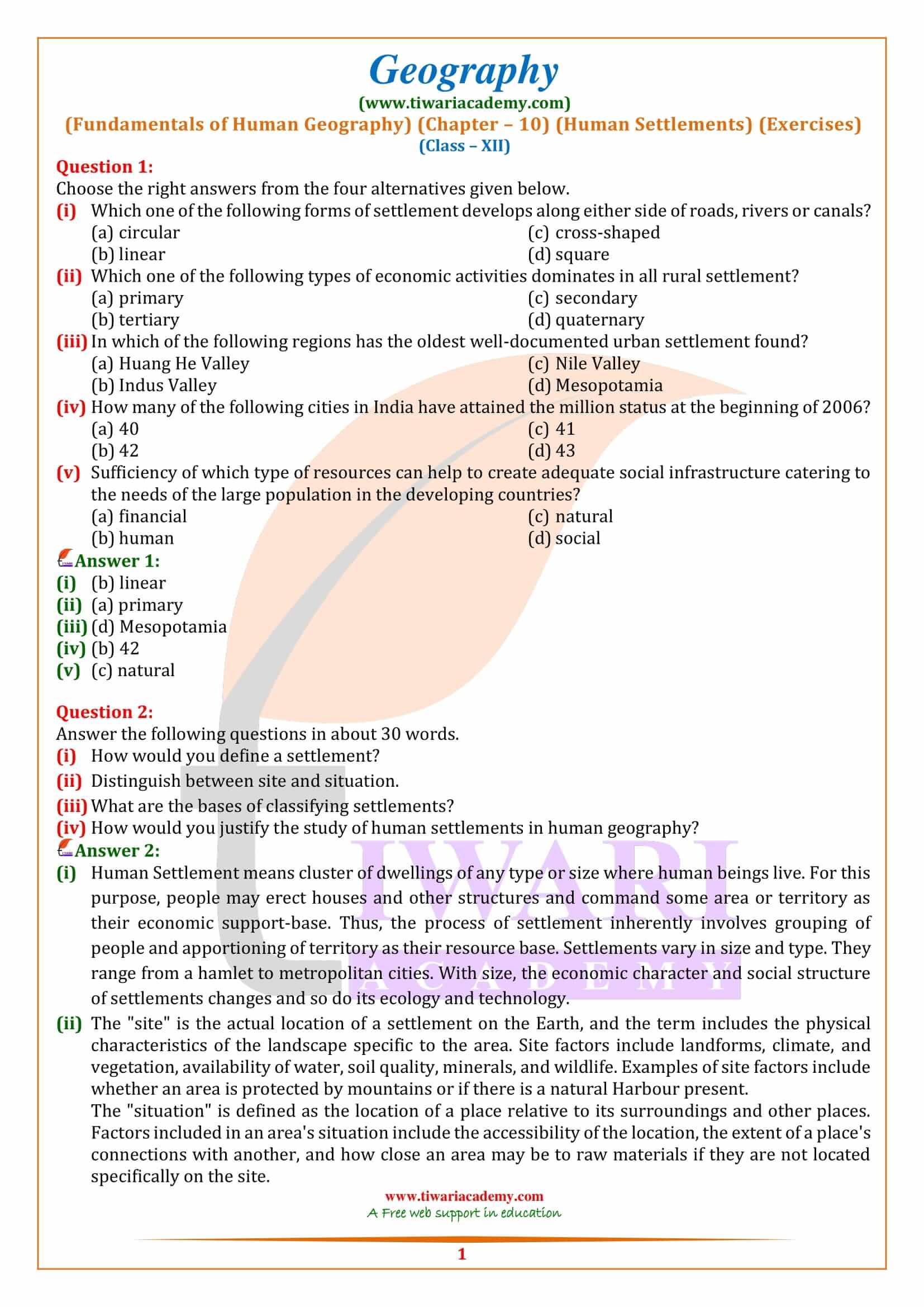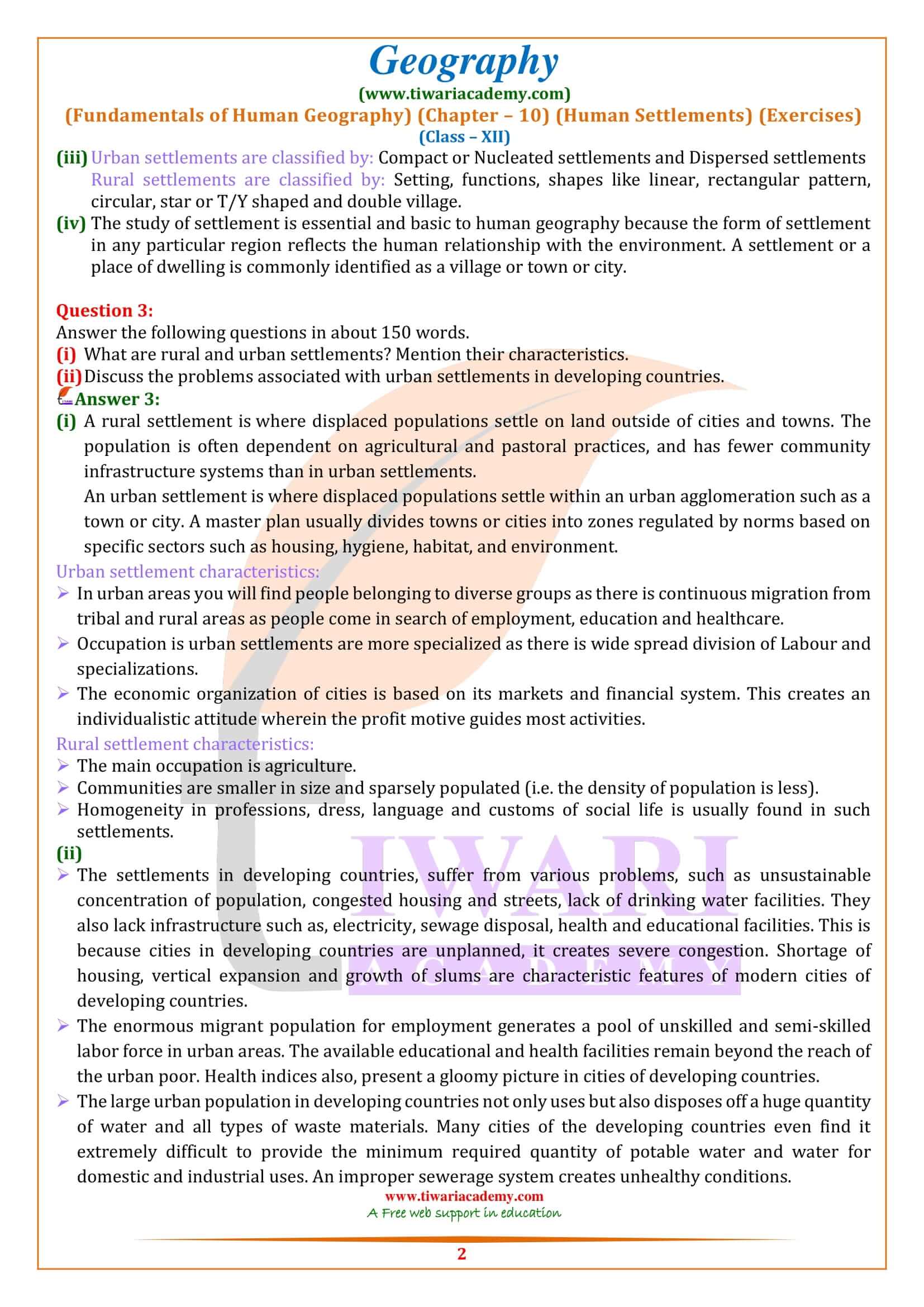NCERT Solutions for Class 12 Geography Chapter 10 Human Settlements in English and Hindi Medium updated for new academic session 2025-26. MCQ based on unit 4 chapter 10 of 12th Geography Fundamentals of Human Geography are given here with answers and explanation.
NCERT Solutions for Class 12 Geography Chapter 10
Class 12 Geography Chapter 10 Human Settlements Question Answers
- Class 12 Geography Chapter 10 NCERT Solutions
- Class 12 Geography Chapter 10 MCQ with Answers
- Class 12 Geography Chapter 10 Important Questions
- Class 12 Geography Chapter 10 Hindi Medium
- Class 12 Geography Chapter 10 NCERT Book
- Class 12 Geography all Chapters Solutions
- Class 12 all Subjects NCERT Solutions
How would you define a settlement?
Human Settlement means cluster of dwellings of any type or size where human beings live. For this purpose, people may erect houses and other structures and command some area or territory as their economic support-base. Thus, the process of settlement inherently involves grouping of people and apportioning of territory as their resource base. Settlements vary in size and type. They range from a hamlet to metropolitan cities. With size, the economic character and social structure of settlements changes and so do its ecology and technology.
Class 12 Geography Chapter 10 MCQ
Which one of the following forms of settlement develops along either side of roads, rivers or canals?
Which one of the following types of economic activities dominates in all rural settlement?
In which of the following regions has the oldest well-documented urban settlement found?
Distinguish between site and situation.
The “site” is the actual location of a settlement on the Earth, and the term includes the physical characteristics of the landscape specific to the area. Site factors include landforms, climate, and vegetation, availability of water, soil quality, minerals, and wildlife. Examples of site factors include whether an area is protected by mountains or if there is a natural Harbour present.
The “situation” is defined as the location of a place relative to its surroundings and other places. Factors included in an area’s situation include the accessibility of the location, the extent of a place’s connections with another, and how close an area may be to raw materials if they are not located specifically on the site.
What are the bases of classifying settlements?
Urban settlements are classified by: Compact or Nucleated settlements and Dispersed settlements.
Rural settlements are classified by: Setting, functions, shapes like linear, rectangular pattern, circular, star or T/Y shaped and double village.
How would you justify the study of human settlements in human geography?
The study of settlement is essential and basic to human geography because the form of settlement in any particular region reflects the human relationship with the environment. A settlement or a place of dwelling is commonly identified as a village or town or city.
What are rural and urban settlements? Mention their characteristics.
A rural settlement is where displaced populations settle on land outside of cities and towns. The population is often dependent on agricultural and pastoral practices, and has fewer community infrastructure systems than in urban settlements.
An urban settlement is where displaced populations settle within an urban agglomeration such as a town or city. A master plan usually divides towns or cities into zones regulated by norms based on specific sectors such as housing, hygiene, habitat, and environment.
Urban settlement characteristics:
- In urban areas you will find people belonging to diverse groups as there is continuous migration from tribal and rural areas as people come in search of employment, education and healthcare.
- Occupation is urban settlements are more specialized as there is wide spread division of Labour and specializations.
- The economic organization of cities is based on its markets and financial system. This creates an individualistic attitude wherein the profit motive guides most activities.
Rural settlement characteristics:
- The main occupation is agriculture.
- Communities are smaller in size and sparsely populated (i.e. the density of population is less).
- Homogeneity in professions, dress, language and customs of social life is usually found in such settlements.





